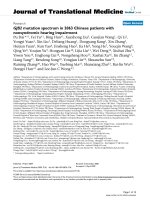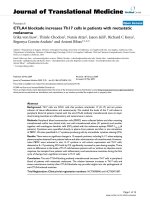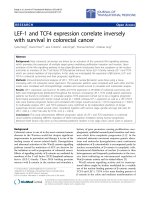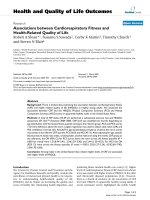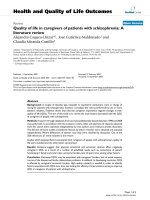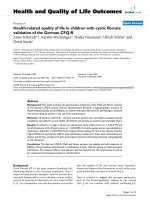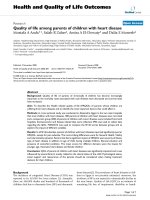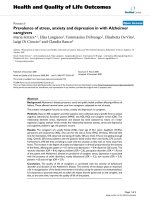báo cáo hóa học:" Displaced proximal humeral fractures: an Indian experience with locking plates" pdf
Bạn đang xem bản rút gọn của tài liệu. Xem và tải ngay bản đầy đủ của tài liệu tại đây (635.1 KB, 8 trang )
RESEARC H ARTIC LE Open Access
Displaced proximal humeral fractures: an Indian
experience with locking plates
Sameer Aggarwal, Kamal Bali
*
, Mandeep S Dhillon, Vishal Kumar, Aditya K Mootha
Abstract
Background: The treatment of displaced proximal humerus fractures, especially in elderly, rema ins controversial.
The objective of this study was to evaluate functional outcome of locking plate used for fixation of these fractures
after open reduction. We also attempted to evaluate the complications and predictors of loss of fixation for such
an implant.
Methods: Over two and a half years, 56 patients with an acute proximal humerus fracture were managed with
locking plate osteosynthesis. 47 of these patients who completed a minimum follow up of 1 year were evaluated
using Constant score calculation. Statistical analysis was done using SPSS 16 and a p value of less than 0.05 was
taken as statistically significant.
Results: The average follow up period was around 21.5 months. Outcomes were excellent in 17%, good in 38.5%,
moderate in 34% whil e poor in 10.5%. The Constant score was poorer for AO-OTA type 3 fractures as compared to
other types. The scores were also inferior for older patients (> 65 years old). Complications included screw
perforation of head, AVN, subacromial impingement, loss of fixation, axillary nerve palsy and infection. A varus
malalignment was found to be a strong predictor of loss of fixation.
Conclusion: Locking plate osteosynthesis leads to satisfactory functional outcomes in all the patients. Results are
better than non locking plates in osteoporotic fractures of the elderly. However the surgery has steep learning
curve and various complications could be associated with its use. Nevertheless we believe that a strict adherence
to the principles of locking plate use can ensure good result in such challenging fractures.
Background
Proximal humeral fractures account for almost 4 to 5%
of all fractures [1,2]. These fractures have a dual age dis-
tribution occuring either in young people following high
energy trauma or in those older than 50 years with low
velocity injuries like simple fall [3]. Three fourths of the
fractures occur in older individuals with an occurrence
three times more often in women than in men [3,4].
Most of the proximal humeral fractures are nondis-
placed or minimally displaced and stable. These can be
treated nonoperatively successfully with early rehabilita-
tion [5-7]. But s everely displaced and comminuted frac-
tures warrant surgical managem ent for optimum
shoulder function. Surgeons should be familiar with the
different treatment options available, including recent
advances in the management of p eriarticular fractures
[8-14] and in locking plate technology [11,15] which are
particularly relevant to the care of these fractures
[10,16-18].
Traditional treatment techniques include open
reduction and internal fixat ion with proximal humeral
plates, hemiarthroplasty, and percutaneous or mini-
mally i nvasive techniques such as pinning, screw osteo-
synthesis, and the use of intramedullary nails
[12-14,19-24]. All these techniques have been asso-
ciated with various complications including implant
failure, loss of reduction, nonunion or malunion of the
fracture, impingement syndrome, and osteonecrosis of
the humeral head [13,25-27]. Locking plate technology
has been developed as a solution to the problems
encountered during conventional plating to treat frac-
tures in osteoporotic bone particularly with metaphy-
seal comminution. The key to this technology is fixed
angle relationship between the screws and plate. The
threaded screw heads are locked into the threaded
* Correspondence:
Deptartment of Orthopaedics, PGIMER, Chandigarh Postgraduate Institute of
Medical Education and Research, Sector 12, Chandigarh - 160 012, India
Aggarwal et al. Journal of Orthopaedic Surgery and Research 2010, 5:60
/>© 2010 Aggarwal et al; licensee BioMed Central Ltd. This is an Open Access article distributed under the terms of the Creative
Commons Attr ibution License ( which permits unrestricted use, distribution, and
reproduction in any medium, provided the original work is properly cited.
plate holes to prevent screw toggle, slide and pull out,
thus diminishing the possibility of primary or second-
ary loss of reduction. Even biomechanical analysis stu-
dies have showed the superiority of such a fixation
when compared to a blade plate fixation [28].
However till now very limited prospective studies have
been done describing the functional outcome and com-
plications following locking plate fixation of proximal
humeral fractures [9,19,29,30]. There may be special
technical requirements for the success of such a plate
which need to be defined. Thus the objective of our
study was to determine the efficacy of proximal
humerus interlocking system (PHILO S), to evaluat e the
complications and to identify the predictors of loss of
fixation of such an implant.
Materials and methods
This prospective study included a series of 56 patients
operated between September 2006 and Feb 2009 with a
proximal humerus locking plate for displaced fracture of
proximal humerus.
Inclusion criteria included:
1. Closed two part fracture with a major displace-
ment of the humeral diaphysis o r three or four part
fracture having a tuber osity displacement enough to
cause a significant subacromial impingement.
2. Patients operated within 10 days of injury.
3. Patients with a minimum follo w up period of
1 year.
Exclusion criteria included:
1. Skeletally immature patients
2. Patients with open fractures,
3. Pathological fractures,
4. Patients with distal neurovascular deficit,
5. Patients with nonunions, malunions or delay in
surgery(>10 days),
6. Displaced three or four part fractures with signifi-
cant bone loss(as seen on CT scan) suggesting insuf-
ficient screw purchase and thus treated by humeral
arthroplasty.
7. Concomitant ipsilateral fracture of distal humerus
or elbow joint,
8. Polytrauma patients with an Injury Severity Score
>16
All proximal humeral fractures met the indications
for the operative treatment as outlined by Neer [31]
i.e. an angulation of articular surface of more than 45
degrees, a displacement between the major fracture
fragments more than 1 cm or a fracture with valgus
impaction [32].
Preoperative true AP, scapular, lateral and axillary X
rays along with CT scans of the area were reviewed by
two of the speciali st orthopedic surgeo ns to define frac-
ture type and outline the plan of surgery. Fracture pat-
terns were classified according AO/OTA system [33]
and the Neer classification [34].
Surgery was performed in supine postion on a radiolu-
cent table using the deltopectoral approach. Fracture
fragments were reduced without stripping periosteum to
best possible anatomical position and reduction was
held with Kirschner wires. Reduction was assessed
under image intensifier. Definitive fixation with proximal
humerus locking plate was done with plate positioned at
least 5 mm distal to the upper end of of the greater
tuberosity and at l east 2 mm posterior to the bicipital
groove thus sparing the t endon of long head of biceps.
Plate was first fixed with K-wires through the holes.
Then with maintenance of prior achieved reduction,
multidirectional screws were used to fix proximal frag-
ments. Rotator cuff, capsule and subscapularis muscle
tears/avulsio ns were repaire d meticulously. Tuberosities,
whenever found fractured, were fixed to the plate apply-
ing tension band principle and using nonabsorbable
sutures. The decision regarding the use of locking or
the cortical screws for plate fixation to the humeral
shaft was left to the discretion of the operating surgeon
with locking screws being preferred for the older
patients with suspected osteoporotic bones.
The post operative rehabili tation protocol included
immediate passive and active assisted range of motion
exercises up to 60 degrees of abduct ion and elevation
with no forced external rotation for 6 weeks. Full ROM
with active exercises was started at 6 weeks.
Patients were followed up on OPD basis at two weeks
postoperatively, then monthly for 6 months, 3 monthly
till the end of 1
st
year and yearly thereafter. At every fol-
low up visit standard AP and axillary radiographs were
obtained and thoroug h clinical assessment done. Antici-
pated postoperative complications included loss of
reduction, fragment displacement, major varus or valgus
def ormation, head necrosis or implant-related problems
(screw perforation, screw loosening or backing out, plate
pullout, or breakage), and surgical and other general
complications such as wound infection or soft-tissue
problems (rotator cuff lesions, adhesions, frozen
shoulders, impingement, and nerve lesions). Functional
outcome was assessed using the Constant score [35].
The Constant score was graded as poor (0-55 points),
moderate (56-70), good (71-85) or excellent (86-100).
To access for the potential effect of learning curve on
the outcome, we arbitrarily divided the patients into two
categories; patients operated by us in or before Decem-
ber 2007 and patients operated by us in or after January
2008.
Aggarwal et al. Journal of Orthopaedic Surgery and Research 2010, 5:60
/>Page 2 of 8
Statistical a nalysis was done using SPSS version 16. A
p-value of less than 0.05 was taken as statistically signifi-
cant while a p-value between 0.05 to 0.1 was taken as
trend towards significance.
Results
During follow up, 3 patients died of unrelated patholo-
gies while 6 patients were lost to follow up. Thus a total
of 47 patients who completed the follow up were evalu-
ated in our study. There were 27 males while 20
females. Mean age of the patients 58.51 years (23-81
years). The average follow up period was 21.49 months
(12-38 months). In our study, out of a total of 47
patients, 27 were found to be older than 65 years of age
suggesting a strong relation of proximal humerus w ith
age related osteoporosis. Further, males 65 years or
younger were more likely to sustain high energy frac-
tures (n = 19/20, 95%) and female 65 years and older
were more likely to sustain l ow energy fracture (n = 19/
27, 70.37%) and this resul t was found to be statistically
significant (p = 0.000). Falls accounted for 55% of frac-
tures, road side accidents 42.5% and 1 fracture was
caused by seizure. Table 1 shows the distribution of
fractures according to age groups while table 2 shows
the distribution of fractures according to Neers and
AO-OTA classification.
All fractures united with an average union time of 20
(16-25) we eks. Table 3 and tabl e 4 shows Constant
scores of the patient s at the final follow up visit accord-
ing to fracture types and age respectively.
We found that patients with Type A fractures had the
highest Constant scores while patients with Type C had
the lowest Constant scores and these results were found
to be statistically significant (p value 0.039). The Con-
stant scores were found to be higher in younger patients
as compared to older patients and this result was also
found to be statistically significant (p value = 0.12).
Overall the function al outcome was found to be moder-
ate to excellent in 90% o f our patients. however almost
10% patients had poor outcome. These results are
shown in table 5. Various complications seen in our
study have been shown in table 6.
A varus head shaft axis on immediate postoperative X-
rays and at last follow up vi sit was found to be a strong
predictor of poor Constant score. However a valgus
alignment was found to have no effect on the final Con-
stant score. This result is highlighted in table 7
We also found that patients opera ted by us earlier
(before Dec 2007) had somewhat inferior Constant
scores at follow up as compared to the patients operated
by us later on (after Jan 2008). A higher number of
complications were also seen in the patients operated by
us earlier. These results are highlighted in tabl e 6 and
table 8.
Discussion
Displaced proximal humeral fractures have always posed
a challenge to treatment especially when associated with
osteoporosis and communition. Such fractures usually
require operative intervention to ensure correct posi-
tioning of the fracture fragments and to allow early
mobilization. Osteoporosis predisposes to low energy
fractures having a complex pattern [36] and difficult
Table 1 Distribution of fracture types according to age
groups
>65 years old <65 years old
AO-OTA Type A 8 3
AO-OTA Type B 11 11
AO-OTA Type C 8 6
Total 27 20
Table 2 Distribution of fracture types according to Neer’s
classification and AO/OTA classification
Neer type n AO/OTA type subtype n subtotal
2 part 13 Type A 2.2 3 11
3.1 3
3.2 5
3 part 23 Type B 1.3 5 22
2.2 3
2.3 6
3.1 5
3.3 3
4 part 10 Type C 3.2 4 14
3.3 10
Fracture dislocation 1
Head splitting fracture 0
Total 47 47
Table 3 Constant score at last follow up according to
fracture type (AO-OTA type)
Type A
(n = 11)
Type B
(n = 22)
Type C
(n = 14)
All types
(n = 47)
P
value
77.54 ± 10.21
(64-92)
73.22 ± 10.67
(52-92)
66.00 ± 12.61
(42-86)
72.08 ± 11.77
(42-92)
0.039*
* significant
Table 4 Constant score at follow up visits according to
the age of patient
>65 years old
(n = 27)
<65 years old
(n = 20)
All
(n = 47)
P
value
68.51 + 11.44 (42-
88)
76.90 + 10.67 (52-
92)
72.08 ± 11.77 (42-
92)
0.013*
* significant
Aggarwal et al. Journal of Orthopaedic Surgery and Research 2010, 5:60
/>Page 3 of 8
fixation owing to poor screw purchase [37,38]. Rate of
failure of fixation is also high.
Various techniques [14,19,21,22, 25] have been utilized
for the treatment of these fractures and include intrame-
dullary nails, plate ost eosynthesis, tension band wiring,
percutaneous K-wire fixation and hemiarthroplasty.
Varying outcomes have been reported with plate osteo-
synthesis for proximal humerus fractures [ 10,13,22,25].
Whereas such fractures in young have uniformly good
results with plate and screw fixation, results in osteo-
porotic fractures of elderly patients are often poor.
Esser [39] reported excellent results in 22 out of his
26 patients of three part and four part fractures of prox-
imal humerus treated with a modified clover leaf plate.
Wijgmanetal[22]etalreportedgoodtoexcellent
results in 87% of their 60 patients with three or four
part proximal humeral fractures operated with a T-but-
tress plate and cerclage wires. Paavolainen et al [40]
reported satisfactory results in 74.2% of their 41 patients
with severe proximal humerus fractures treated with
plate and screw devices. However all these authors
found poor results in 4 part fractures and recommended
a prosthetic replacement in such patients.
The recent evolution of locking plate technology for
proximal humerus fractures seems to have revolutio-
nized the management of these fractures. However there
have been very limited prospective studies investigating
the results of locking plates for open reduction and
internal fixation of proximal humeral fract ures
[9,19,29,30,41]. Most of these studies have reported
good functional outcomes and r ecommended the use of
locking plates for proximal humerus fractures especially
in elderly patients with poor bone quality.
The results of our prospective study showed good or
excellent outcomes in around 56% of our patients.
These results were somehow inferior to those reported
in the western literature. Patients operated by us earlier
when the loc king plate principles had just been intro-
duced showed somewhat inferior results as compared to
those operated later and this result showe d a trend
towards significance (p = 0.082) on Chi square analysis.
Also a higher number of complication s were seen in the
patients operated by us earlier. This leads us to believe
that application of locking plate technology for proximal
humerus fractures has a steep learning curve and appro-
priate surgical technique is very important for achieve
good functional outcome.
We also found inferior results with AO -OTA type 3
fractures which is expected as these fractures are more
complex and open reduction and internal fixation is
tougher. The results were also inferior in patients with
age older than 65 years. Neverthless our results in older
age patients a re better than those of traditional plates
used in such osteoporotic fract ures [22,39,40]. We, thus
believe, that a locking plate device for proximal humerus
fractures gives a satisfactory outcome in most of the
patients including those with old the age and poor bone
density.
As it was a l arge cohort of patients, various complica -
tions were encountered by us. Varus malalignment
(head shaft angel < 120°) was noted immediately post-
operatively i n 2 of our patients (Fig 1), one each in C2
and and C3 group. At further follow up, 3 more patients
showed varus collapse. Subsequent loss of reduction was
seen in all five of these patien ts. Three of these patients
underwent revision surgery with implant rem oval and
new proximal humerus locking plate. Other two were
operated by shoulder hemiarthroplasty later on consid-
ering the highly comminuted and intra-articular nature
Table 5 Functional outcome on the basis of Constant
score at the last follow up visit
Excellent Good Moderate Poor Total
Total 8 18 16 5 47
AO-OTA Types (A/B/
C)
4/3/1 3/10/5 4/7/5 0/2/3 11/22/
14
Age (<65 yrs/>65
yrs)
5/3 9/9 5/11 1/4 20/27
Percentage 17.02% 38.30% 34.04% 10.64% 100%
Table 6 Various complications seen in our study
Complications No. of patients Early cases* Late cases**
Failure of fixation or screw back out 5 3 2
Primary screw perforation of humeral head 6 5 1
Symptomatic AVN humeral head 2 0 2
Subacromial impingement 5 4 1
Non-union/Delayed union 0 0 0
Axillary nerve palsy 2 1 1
Deep wound infection 3 2 1
Superficial wound infection 6 4 2
* Before Dec 2007
** After Jan 2008
Aggarwal et al. Journal of Orthopaedic Surgery and Research 2010, 5:60
/>Page 4 of 8
of the fracture. None of the patients with a neutral or
valgus alignment had a loss of fixation at long term fol-
low up. We thus found that a varus malalignment was a
strong predictor of loss of fixation.
Six patients were found to have primary screw per-
foration (Fig 2) of the humeral head that was unrecog-
nized during the surgery. An early implant removal was
done in two of these patients while four of the patients
underwent a repeat surgery to exchange the screws for
shorter screws.
Symptomatic humeral head AVN was noted in two
patients with C.3.3 fractures at follow up visits. Both of
them were later operated with hemiarthroplasty and the
result was found to be good.
We observed subacromial impingement to start with
in 5 of our patients. This was thought to be a result o f
too far cranial positioning of the plate. However with
time all of these pat ients improved and plate removal
wasdoneinonly2ofthesepatientsafterthefracture
had united.
No case of non union or delayed union was seen.
There were 2 cases of axillary nerve p alsy. However no
intervention was required in any of these and both the
patients improved within 1 year of follow u p. Deep
wound infection was seen in 3 patients. Two of these
settled after debridement surgeries. Implant removal was
done in one of the patients who was reoperated later;
repeat plating being done 4 months after the infection
had settled. However superficial wound infection, not
requiring a formal debridement, was found to be com-
mon, seen in 6 of our patients. All these patients subse-
quently settled with an extended course of IV antibiotics
and local wound treatment.
In our present study, proximal humerus locking plate
has shown promising result in displaced and
comminuted proximal humeral fractures. Loss of reduc-
tion occurred in 10% of patients(5 patients) after
implant loosening in proximal fragments. Varus malre-
duction (Fig 3) has been found to be a predictor of such
of reduction and must be avoided intraoperatively at
every cost.
Most of the complications in our series occurred
during our initial experience (table 5). Out of the
6 patients with screw perforations into the joint, 5
happened in our earlier cases. As our experience
increased, we realized that the best way to avoid this
was to get confirmatory radiographs throughout the
arc of rotation (maximum internal to maximum exter-
nal rotation) after the hole has been dril led (with drill
bit in situ) to get the exact len gth of the screw. We
preferred to put a smaller sized screw whenever the
length measured fell between two screw sizes. Impin-
gement occurred in 5 of our cases and again 4 of them
Table 7 Comparison of head shaft axis with mean Constant score at follow up
Immediate postoperative (no.) Last follow up (no.) Constant score at last follow up
Normal 38 37 73.05 ± 12.01
Major Varus (<120°) 2 5 63.60 ± 12.44
Major Valgus (>160°) 7 5 73.40 ± 6.38
Table 8 Comparison of the cases operated by us earlier
(before Dec 2007) as compared to the cases done later
(after Jan 2008)
Cases done
earlier
Cases done later
on
p-
value
Number 19 28
AO-OTA types (A/B/C) 7/5/7 5/17/6
Mean Constant score 68.31 ± 13.47 74.64 ± 9.92 0.082**
Number of
complications (29)
19 10
** trend towards significance
Figure 1 Immediat e post operative X-ray in a patient showing
varus collapse and plate pull out.
Aggarwal et al. Journal of Orthopaedic Surgery and Research 2010, 5:60
/>Page 5 of 8
were in the in itial experience. We feel that the best
way to avoid superior placement of the plate is to pro-
visionally fix the plate with k-wires through the super-
ior most holes of plate (small holes meant for k-wires),
check under fluoroscopy throughout the arc of abduc-
tion and then proceed further. All the screw pull outs
occurred in osteoporo tic cases. We personal ly feel that
the best way to tackle this problem is to put as many
screws in the head as possible; however we did not
evaluate this factor as the number of osteoporotic
cases was too small to be analyzed. Augmentation with
PMMA cement is an option and Matsuda et a l [42]
have reported a series of 5 such cases. However we do
not have any personal experience with cement aug-
mentation. Most of the infections especially superficial
ones had also occurred during our initial phase and we
feel that this was mainly due to poor soft tissue hand-
ling and raising of excessive skin flaps. As our surgical
technique evolved, infectious complications were found
to occur less frequently.
A potential limitation of our study was the absence of
a control group treated by a different modality. Thus we
cannot actually determine if any other method of treat-
ment would have led to different results. Nevertheless
our results are better than those of the previous studies
in which plate osteosynthesis other than locking plate
has been used [22,39,40]. Also the prospectiv e design of
ourstudy,thelargesamplesize(47patients)anda
Figure 2 Immediat e post operative X-ray in a patient showing
primary screw perforation.
Figure 3 Varus collapse in a patient on follow up X-rays, both AP and lateral.
Aggarwal et al. Journal of Orthopaedic Surgery and Research 2010, 5:60
/>Page 6 of 8
decent average follow up period (21.5 months) adds
strength to our study.
In a recently published study protocol by Handoll et al
[43], the authors aim to undertake a multicentric rando -
mized control trial to evaluate the efficacy and cost
effectiveness of surgical versus standard nonsurgical
treatment for adults with an acute closed displaced frac-
ture of the proximal humerus with involvement of the
surgical neck. Probably the outcome of this study will
further add to our existing knowledge about manage-
ment of these complex fractures of proximal humerus.
To conclude, we believe that a locking plate for the
treatment of proximal humerus fractures uniformly
leads to a satisfactory functional outcome over long
term follow up in most of the patients. Although the
results are poorer in old aged individuals with osteo-
porosis, they are nevertheless better than those achieved
with non locking plates. The AO-OTA type 3 fractures
have poorer results as compared to type 1 or type 2
fractures. However the results in type 3 fracture are
good enough to recommend open reduction and inter-
nal fixation with locking plates in these patients. A
varus malalignment was found to be a strong predictor
of loss of fixation and should be avoided if possible. The
surgery carries a steep learning curve and various com-
plications could be associated with it. However, proper
use of locking plate principles and a meticulous soft tis-
sue repair with aggressive post operative rehabilitation
go a long way in ensuring a satisfactory functional
outcome.
Authors’ contributions
KB reviewed the literature and wrote the paper. SA and MSD were main
operating surgeons in the whole series and critically reviewed the paper. KB,
VK and AKM maintained all the records of the patients and followed them.
All the authors read and approved the final manuscript.
Competing interests
The authors declare that they have no competing interests.
Received: 18 June 2010 Accepted: 23 August 2010
Published: 23 August 2010
References
1. Helmy N, Hintermann B: New trends in the treatment of proximal
humerus fractures. Clin Orthop Relat Res 2006, 442:100-108.
2. Court-Brown CM, Caesar B: Epidemiology of adult fractures: A review.
Injury 2006, 37:691-697.
3. Chu SP, Kelsey JL, Keegan TH, et al: Risk factors for proximal humerus
fracture. Am J Epidemiol 2004, 15(160):360-367.
4. Lind T, Kroner K, Jensen J: The epidemiology of fractures of the proximal
humerus. Arch Orthop Trauma Surg 1989, 108(5):285-287.
5. Zyto K: Non-operative treatment of comminuted fractures of the
proximal humerus in elderly patients. Injury 1998, 29:349-52.
6. Gaebler C, McQueen MM, Court-Brown CM: Minimally displaced proximal
humeral fractures: epidemiology and outcome in 507 cases. Acta Orthop
Scand 2003, 74:580-5.
7. Koval KJ, Gallagher MA, Marsicano JG, Cuomo F, McShinawy A,
Zuckerman JD: Functional outcome after minimally displaced fractures of
the proximal part of the humerus. J Bone Joint Surg Am 1997, 79:203-7.
8. Cornell CN: Internal fracture fixation in patients with osteoporosis. JAm
Acad Orthop Surg 2003, 11:109-119.
9. Fankhauser F, Boldin C, Schippinger G, et al: A new locking plate for
unstable fractures of the proximal humerus. Clin Orthop Relat Res 2005,
430:176-181.
10. Gerber C, Werner CM, Vienne P: Internal fixation of complex fractures of
the proximal humerus. J Bone Joint Surg Br 2004, 86:848-855.
11. Haidukewych GJ: Innovations in locking plate technology. J Am Acad
Orthop Surg 2004, 12:205-212.
12. Robinson CM, Page RS: Severely impacted valgus proximal humeral
fractures: Results of operative treatment. J Bone Joint Surg Am 2003,
85:1647-1655.
13. Wanner GA, Wanner-Schmid E, Romero J, et al: Internal fixation of
displaced proximal humeral fractures with two one-third tubular plates.
J Trauma 2003, 54:536-544.
14. Resch H, Povacz P, Frohlich R, et al: Percutaneous fixation of three- and
four-part fractures of the proximal humerus. J Bone Joint Surg Br 1997,
79:295-300.
15. Strohm PC, Kostler W, Sudkamp NP: Locking plate fixation of proximal
humerus fractures. Techniques in Shoulder & Elbow Surgery 2005, 6:8-13.
16. Resch H, Beck E, Bayley I: Reconstruction of the valgus-impacted humeral
head fracture. J Shoulder Elbow Surg 1995, 4:73-80.
17. Zyto K, Ahrengart L, Sperber A, et al: Treatment of displaced proximal
humeral fractures in elderly patients. J Bone Joint Surg Br 1997,
79:412-417.
18. Zyto K, Wallace WA, Frostick SP, et al: Outcome after hemiarthroplasty for
three- and four-part fractures of the proximal humerus. J Shoulder Elbow
Surg 1998, 7:85-89.
19. Koukakis A, Apostolou CD, Taneja T, et al: Fixation of proximal humerus
fractures using the PHILOS plate: early experience. Clin Orthop Relat Res
2006, 442:115-20.
20. Park MC, Murthi AM, Roth NS, et al: Two-part and three-part fractures of
the proximal humerus treated with suture fixation. J OrthopTrauma 2003,
17:319-25.
21. Schmal H, Klemt C, S¨udkamp NP: [Evaluation of shoulder arthroplasty in
treatment of four-fragment fractures of the proximal humerus].
Unfallchirurg German 2004, 107:575-82.
22. Wijgman AJ, Roolker W, Patt TW, et al: Open reduction and internal
fixation of three and four-part fractures of the proximal part of the
humerus. J Bone Joint Surg Am 2002, 84:1919-25.
23. Mittlmeier TW, Stedtfeld HW, Ewert A, et al: Stabilization of proximal
humeral fractures with an angular and sliding stable antegrade locking
nail (Targon PH). J Bone Joint Surg Am 2003, 85(Suppl 4):136-46.
24. Calvo E, de Miguel I, de la Cruz JJ, et al: Percutaneous fixation of
displaced proximal humeral fractures: indications based on the
correlation between clinical and radiographic results. J Shoulder Elbow
Surg 2007, 16:774-81.
25. Kristiansen B, Christensen SW: Plate fixation of proximal humeral fractures.
Acta Orthop Scand 1986, 57:320-3.
26. Hintermann B, Trouillier HH, Sch¨afer D: Rigid internal fixation of fractures
of the proximal humerus in older patients. J Bone Joint Surg Br 2000,
82:1107-12.
27. Meier RA, Messmer P, Regazzoni P, et al: Unexpected high complication
rate following internal fixation of unstable proximal humerus fractures
with an angled blade plate. J Orthop Trauma 2006, 20:253-60.
28. Siffri PC, Peindl RD, Coley ER, et al: Biomechanical analysis of blade plate
versus locking plate fixation for a proximal humerus fracture:
comparison using cadaveric and synthetic humeri. J Orthop Trauma 2006,
20:547-54.
29. Kettler M, Biberthaler P, Braunstein V, et al: [Treatment of proximal
humeral fractures with the PHILOS angular stable plate. Presentation of
225 cases of dislocated fractures]. Unfallchirurg German 2006, 109:1032-40.
30. Südkamp N, Bayer J, Hepp P, et al: Open reduction and internal fixation
of proximal humeral fractures with use of the locking proximal humerus
plate. Results of a prospective, multicenter, observational study. J Bone
Joint Surg Am 2009, 91(6):1320-8.
31. Neer CS: Displaced proximal humeral fractures-II. Treatment of three-part
and four-part displacement. J Bone Joint Surg Am 1970, 52(6):1090-103.
32. Glannoudis PV, Schneider E: Principles of fixation of osteoporotic
fractures. J Bone Joint Surg Br 2006, 88(10):1272-8.
Aggarwal et al. Journal of Orthopaedic Surgery and Research 2010, 5:60
/>Page 7 of 8
33. Muller ME, Nazarian S, Koch P, et al: The Comprehensive Classification of
Fractures of Long Bones. Berlin, Germany: Springer-Verlag 1990.
34. Neer CS: Displaced proximal humeral fractures. I. Classification and
evaluation. J Bone Joint Surg Am 1970, 52:1077-1089.
35. Constant CR, Murley AH: A clinical method of functional assessment of
the shoulder. Clin Orthop 1987, 214:160-4.
36. Hertel R: Fractures of the proximal humerus in osteoporotic bone.
Osteoporos Int 2005, 16(Suppl 2):S65-S72.
37. Szyszkowitz R, Seggl W, Schleifer P, et al: Proximal humeral fractures.
Management techniques and expected results. Clin Orthop 1993,
292:13-25.
38. Cofield RH: Comminuted fractures of the proximal humerus. Clin Orthop
1988, 230:49-57.
39. Esser RD: Treatment of three and four part fractures of the proximal
humerus with a modified cloverleaf plate. J Orthop Trauma 1994, 788-91.
40. Paavolainen P, Bjorkenheim JM, Slatis P, et al: Operative treatment of
severe proximal humeral fractures. Acta Orthop Scand 1983, 54:374-9.
41. Bigorre N, Talha A, Cronier P, et al: A prospective study of a new locking
plate for proximal humeral fracture. Injury 2009, 40(2):192-6.
42. Matsuda M, Kiyoshige Y, Takagi M, et al: Intramedullary bone-cement
fixation for proximal humeral fracture in elderly patients. A report of 5
cases. Acta Orthop Scand 1999, 70(3):283-5.
43. Handoll H, Brealey S, Rangan A, et al: Protocol for the ProFHER (PROximal
Fracture of the Humerus: Evaluation by Randomisation) trial: a
pragmatic multi-centre randomised controlled trial of surgical versus
non-surgical treatment for proximal fracture of the humerus in adults.
BMC Musculoskelet Disord 2009, 10:140.
doi:10.1186/1749-799X-5-60
Cite this article as: Aggarwal et al.: Displaced proximal humeral
fractures: an Indian experience with locking plates. Journal of
Orthopaedic Surgery and Research 2010 5:60.
Submit your next manuscript to BioMed Central
and take full advantage of:
• Convenient online submission
• Thorough peer review
• No space constraints or color figure charges
• Immediate publication on acceptance
• Inclusion in PubMed, CAS, Scopus and Google Scholar
• Research which is freely available for redistribution
Submit your manuscript at
www.biomedcentral.com/submit
Aggarwal et al. Journal of Orthopaedic Surgery and Research 2010, 5:60
/>Page 8 of 8
